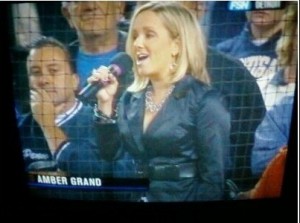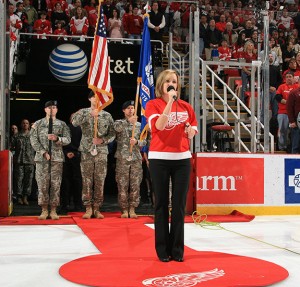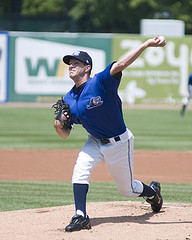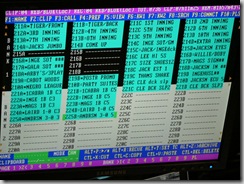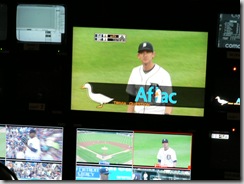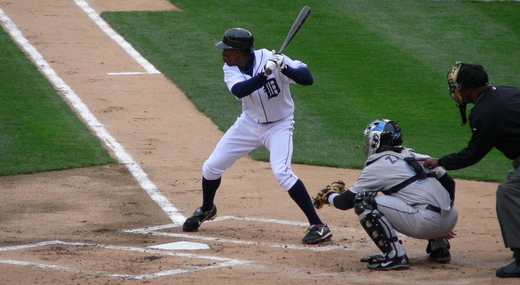For those unfamiliar with the Midwest League playoff race, the Whitecaps are neck and neck with Fort Wayne for the final playoff spot in the league. West Michigan and Fort Wayne shared an equal second-half record going into play on Saturday. That meant that the two teams squared off for a dramatic three-game series with the winner advancing to the post season and the loser packing it up for the year. After a season of evaluating box scores from afar, I decided to make the trip to Grand Rapids to see the Whitecaps battle it out.
On Saturday, West Michigan sent RHP Brian Stroud to the mound. The recently promoted 22-year-old looked strong over 6 innings as he held Fort Wayne to 2 unearned runs. Unfortunately, reliever Patrick Cooper couldn’t keep the Fort Wayne TinCaps at bay and allowed 4 ER in an inning of work while taking the loss.
Clay Jones (DH) provided offensive spark and went 3-4 from the plate. Castellanos was 2-5 with an RBI and Hernan Perez (SS) was 1-4. The Whitecaps trailed most of the game, but staged a valiant comeback with 3 runs in the bottom of the 8th. They fell a run short as Nick Castellanos was called for catcher inference erasing Hernan Perez who was attempting to steal second for the final out of the game.
Prior to the game, I had an opportunity to talk with three top prospects at the A level: Nick Castellanos, Hernan Perez, and Kevin Eichhorn. Before I get to the interviews, I want to thank Ben Chiswick, director of media affairs and play-by-play man for the Whitecaps, and also, of course, the players who allowed me to talk with them in the heat of a playoff race. Finally, I’d like to thank Alex Burgos who lent his time and translated during my interview with Hernan Perez.
Nick Castellanos – 3B, 6’4’’ 195 lbs.
The 19-year-old righty was the 44th overall pick in the 2010 draft and spent that year in the Gulf Coast League. He has played at West Michigan for all of 2011 and has had a record-breaking season as his 158 hits represent the new franchise single-season record. He broke Robert Fick’s previous mark of 157. The third baseman has hit .313 and slugged .438 in 504 ABs. Castellanos specifically did not want to address the record as he maintained his focus on the team’s critical three game series.
DTW: You’ve had a spectacular year, what have you learned in your first year at the A level?
Nick Castellanos (NC): How to be a professional on and off the field, how to be a good teammate, how to recognize certain situations.
DTW: Right now you’re involved in a three-game series which determines if you’ll make the playoffs, what kind of impact does that experience have on your development as a professional ballplayer?
NC: This is going to be the first playoff-type experience I’ll have as a pro baseball player, so I’m excited.
DTW: Jim Leyland constantly mentions that each game is just another game and stresses treating them similarly. Do you think that’s applicable or are you guys fired up over this series?
NC: Actually everyone’s pretty relaxed, you know, like Leyland said, it is another game. You can’t really go in amped up because it is just another game.
DTW: Your strikeout to walk ratio is a little bit high, is there anything you’re going to work on in the offseason to work on it?
NC: It’s not something that I’m going to stress out about. I’m still going to go up there looking to hit. It’s probably something that is going to happen as I develop as a player.
DTW: What is the main thing you want to work on this offseason?
NC: I want to work on everything.
DTW: What is your favorite aspect of your game?
NC: Hitting.
Hernan Perez – 2B, 6’0’’ 160 lbs.
Perez was signed as a non-drafted free agent in July, 2007. Since then, he has spent time in the VSL, BCL, and Lakeland. In 2010, he was promoted to West Michigan and has played there for the last 2 seasons. In his first three years of professional baseball, he hit .226, .239, and .235. This year, however, he has hit .259, including .306 in the first half. As a result, he was named a mid-season all-star. The speedy second-basemen has stolen 23 bases in 29 attempts.
DTW: The minor leagues is about individual development, but what does it mean to you to be playing in a three-game, do-or-die, series as part of this team?
Hernan Perez (HP): It’s definitely a team game, ultimately, but there’s no pressure right now I’m just doing all I can to help the team and hopefully we come out on top.
DTW: What did it mean to you to make the 2011 mid-season all-star team?
HP: I’m really proud of myself for making it. That’s always something that I’ve wanted to do. I give all the credit to my coaches for helping me prepare.
DTW: Your average is about 30 points higher than it’s been in the past. Is there anything you’re doing differently this year?
HP: Being more patient and only swinging at good pitches. Last year I didn’t really have an approach and swung at bad pitches.
DTW: What MLB player do you try to model yourself after?
HP: Robinson Cano
Kevin Eichhorn – RHP, 6’0’’ 175 lbs.
In 25 starts, covering 152 innings, Eichhorn is 11-5 with a 3.61 ERA, 109 K’s, 33 BB’s and a .256 average against. He was acquired by the Tigers in January, 2011 from the Diamondbacks in the Armando Gallaraga deal. He was originally picked in the 3rd round of the first-year player draft in 2008.
DTW: This is, by far, the most innings you’ve pitched as a professional. How’s your arm holding up?
Kevin Eichhorn (KE): It feels really good. I think this is double what I’ve thrown before.
DTW: What pitches do you feature in a typical start?
KE: Usually a 2-seam and 4-seam fastball, changeup, and curveball.
DTW: Will you try to add anything during the offseason or just work on the pitches you already have?
KE: I might try to add either a hard curveball or maybe a slider.
DTW: Your strikeout to walk ratio is terrific, but your average against is .256, it seems like you have great control but hitters are able to put the ball in play a little bit too much. Do you think that will improve as you move through the ranks and maybe get a little bit tougher defense behind you?
KE: I’ve had really good defense here. I just need to fine tune the strike zone, maybe throw the ball a little bit further off the plate. Try to get more bad swings. Just control the zone a little bit better.
DTW: Have you noticed any major differences between the two organizations (Arizona and Detroit)?
KE: A lot of the same stuff, different climates in spring training. Just getting to know the new guys. Everyone’s been real nice.
DTW: What does this series mean to you as a Whitecap?
KE: I really want to win, our team always wants to win, so, we’re going for the whole thing and we’re going to try to put a beating on them and play hard.
DTW: What are you planning to do this offseason that isn’t baseball related?
KE: See the family, rest the arm a little bit. I like playing music.
DTW: What kind of music?
KE: Reggae and rock with my brothers and cousin.
